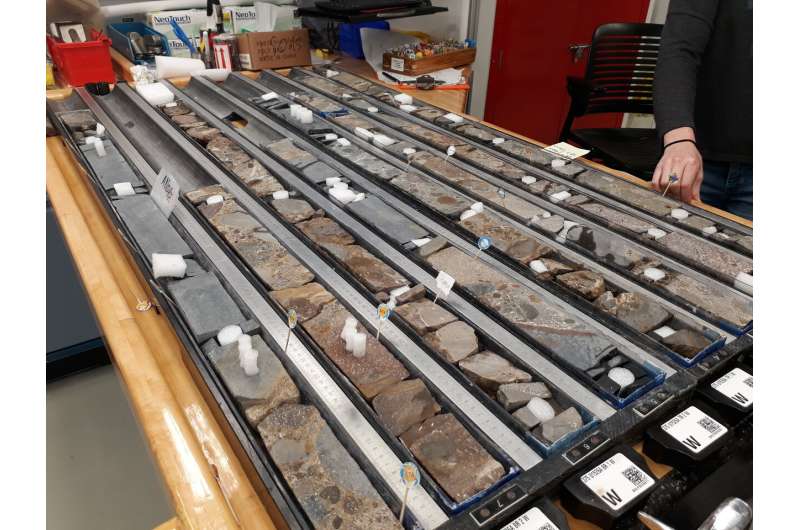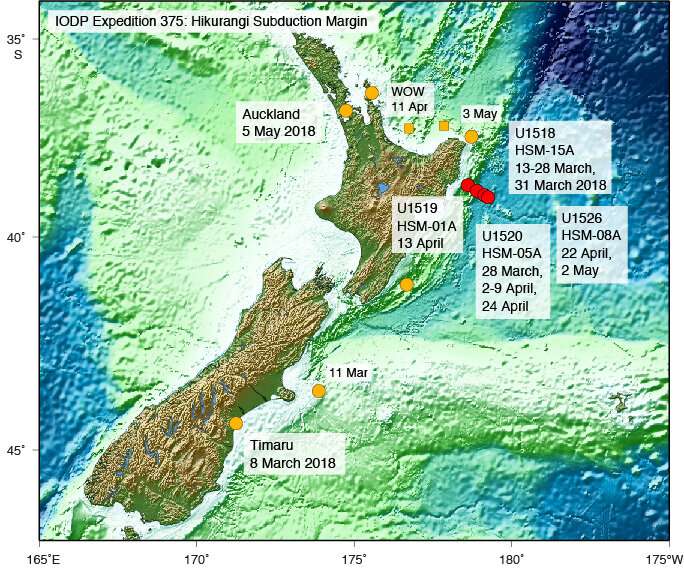Scientists get first look at cause of 'slow motion' earthquakes

An international team of scientists has for the first time identified the conditions deep below the Earth's surface that lead to the triggering of so-called 'slow motion' earthquakes.
These events, more commonly known as slow slip events, are similar to regular sudden and catastrophic earthquakes but take place on much longer timescales, usually from days to months.
By drilling down to just over 1km deep in water depths of 3.5km off the coast of New Zealand, the team have shown that the fault zone areas in which slow slip events occur are characterised by a 'mash up' of different rock types.
The results, published today in the journal Science Advances, showed that the areas are comprised of extremely rough sea floor topography made of rocks that varied markedly in size, type and physical characteristics.
The lead author of the paper, Dr. Philip Barnes of New Zealand's National Institute of Water and Atmospheric Research (NIWA), described that 'some rocks were mushy and weak, whilst others were hard, cemented and strong.'
This has given scientists the first-ever look at the types and properties of rocks directly involved in slow motion earthquakes and begins to answer some of the major outstanding questions surrounding these unique events, such as whether or not they can trigger larger, more damaging earthquakes and tsunamis.

Co-author of the study Dr. Ake Fagereng, from Cardiff University's School of Earth and Ocean Sciences, said: "This was the first effort to sample the rocks that host slow slip events, and the striking, immediate observation is that their strengths are hugely variable. One can therefore visualise the slow slip source as a mixture of hard and weak rocks, and use this as a starting point for models of how slow slip occurs."
First discovered on the San Andreas fault in California, but since 2002 found to occur in several other locations, slow slip events remain a relative mystery to scientists, who are endeavouring to find out how, where and why they occur and what drives their behaviour.
As part of their study, the international team undertook two International Ocean Discovery Program (IODP) expeditions aboard the JOIDES Resolution research vessel to the Hikurangi subduction zone off the east coast of the North Island in 2017 and 2018.
This was the first time that scientists had studied, and directly sampled, rocks from the source region of slow slip events using ocean floor scientific drilling methods.

The Hikurangi subduction zone is New Zealand's largest earthquake fault and is one of the best places in the world to study slow slip because here these events occur close to the sea floor which makes drilling to collect rock samples a lot easier.
For instance, Laura Wallace of GNS Science, New Zealand, describes that the 2016 Kaikoura earthquake triggered a series of major slow slip events on the Hikurangi subduction zone—where the Pacific Plate dives beneath the eastern North Island—and was the most widespread episode of slow slip seen in New Zealand since they were first discovered in the country.
These slow slip events following the Kaikoura earthquake released a large amount of built-up tectonic energy and lasted over the weeks and months following the earthquake.
During the expedition the team drilled two boreholes to obtain a sequence of rocks and sediments on the incoming (Pacific) plate approaching the North Island.
The drilling data were interpreted together with seismic reflection profiles—or pictures of the layers under the surface of the earth which are created at sea by sound waves.
The study has indicated that the co-existence of these contrasting rock types in the fault zone may lead to the slow slip movements observed offshore from Gisborne, and perhaps elsewhere at subduction boundaries around the world.
Indeed, Dr. Barnes says that the research will have direct relevance not only to New Zealand, but to areas like Japan and Costa Rica, which sit on the Ring of Fire—the perimeter of the Pacific Ocean basin where many earthquakes and volcanic eruptions occur.
"We now know that a highly variable mixture of rock strengths is part of the recipe for slow slip. This opens for new studies of how such mixtures deform, why they can generate slow slip, and under what conditions (if any) they can also generate damaging earthquakes. This may help address the outstanding question of how earthquakes and slow slip events interact," continued Dr. Fagereng.
More information: "Slow slip source characterized by lithological and geometric heterogeneity" Science Advances (2020). DOI: 10.1126/sciadv.aay3314 , advances.sciencemag.org/content/6/13/eaay3314
Journal information: Science Advances
Provided by Cardiff University





















